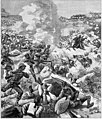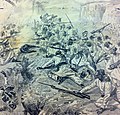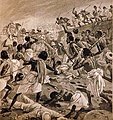Italo-Ethiopian War (1895-1896)
| date | 1895 to 1896 |
|---|---|
| place | Ethiopia |
| output | Ethiopian victory |
| Peace treaty | Peace of Addis Ababa (1896) |
| Parties to the conflict | |
|---|---|
|
|
|
| Commander | |
|
|
|
| Troop strength | |
| 18,000 | 100,000+ |
| losses | |
|
15,000 dead |
17,000 dead |
Halai - Coatit - Senafe - Debra Ailà - Amba Alagi - Mek'elē - Adua
Battlegrounds of the war in 1895 and 1896 (as seen from Italian Eritrea) |
The First Italo-Ethiopian War was a colonial war between Italy and Ethiopia from 1895 to 1896.
background
Italian attempts to appropriate Ottoman territories at the Berlin Congress in 1878 had failed, even if Italy succeeded for the first time in a congress of the great powers. Further efforts to gain influence in North Africa through economic activities were also unsuccessful. The French occupation of Tunisia in 1881 disappointed Italy's hopes of acquiring it and led to the resignation of Prime Minister Benedetto Cairoli . The majority of European immigrants were Italians and the area with Sicily and Pantelleria would have allowed control over the sea routes there. This setback caused Rome to join the Triple Alliance on May 20, 1882 . Germany and Austria-Hungary assured Italy a free hand in the unoccupied areas of North and East Africa, but refused to support military conflicts that might arise from Rome's quest for colonies . On the other hand, membership in the Triple Alliance, out of consideration for the allies, led to a rein in the Irredenta , which was directed to Austro-Hungarian areas in Trento , Trieste and Dalmatia . The revalued Italy now turned its attention completely to Africa. In 1882 it acquired the Bay of Assab and after the weakening of Egypt as a result of the Mahdi uprising in 1885, Massaua became a second port on the Red Sea . Trade bases in Somalia followed (initially in competition with the German-East African Society ).
As early as 1887 an attempt to advance from Eritrean territory to Ethiopia during the Eritrea War failed with the destruction of an Italian unit in the Battle of Dogali . Foreign Minister Carlo Felice Nicolis Robilant and War Minister Cesare Ricotti-Magnani had to resign soon afterwards, but Robilant was still able to secure Germany's support for compensation in the event of French territorial expansion. From 1889/90 the coastal area between Assab and Massaua was taken over . From them Italy formed its first colony, Eritrea . This was followed by the annexation of the southern part of the Somali peninsula, while Germany completely stopped efforts there . Even before Negus Yohannes IV died in the Battle of Gallabat in 1889 , the Italians had supported the later Negus Menelik II with weapons and money.
On May 2, 1889, King Umberto I concluded the Ucciali friendship treaty with Emperor Menelik II , which was to form the preliminary stage to the Italian expansion into Ethiopia. Ethiopia recognized in him the Italian colonial possession on the Red Sea. The Italian text read as recognition of Ethiopia that it is now an Italian protectorate . There was no mention of this in Amharic . Prime Minister Francesco Crispi announced the new protectorate status to the other great powers, and Menelik II demanded that this interpretation be withdrawn. When Italy refused, Ethiopia terminated the treaty in 1893. Thereupon Italy blocked the coast with its fleet, promoted tribal conflicts and supplied opponents of Menelik II with weapons, B. the Ethiopian governor of Tigray ( Mengesha Yohannes ) and the Afar sultan of Aussa . Due to the British-Italian treaties concluded in 1891 and 1894, Italy was supported by Great Britain, while France supplied weapons to Menelik II. Against the background of the French-Italian, French-British and Russian-British antagonisms that still existed in the 1890s, Ethiopia was also supported by France's ally Russia.
Opening phase of the war
In June 1894 the governor of Tigray submitted to the Ethiopian emperor. In December 1894 the Italians themselves crossed the borders, marched into Tigray and briefly occupied Adua . At first Mengesha Yohannes faced the Italians alone. Fighting began in January 1895, and after their victories in the battles of Coatit (Qwatit) and Senafe , the Italians reoccupied Adua and Adigrat and Tigray's capital, Mek'ele . As early as April 1895, however, they had to evacuate Adua, even though they pushed deeper into Tigray after the end of the rainy season in October 1895, won at Debra Ailà for the last time and even occupied Amba Alagi. Menelik II was still trying to negotiate, which the Italian commander-in-chief Oreste Baratieri refused.
Turn of the war
In November 1895, Menelik finally intervened in the fighting. In December the Italians lost the Battle of the Amba Alagi , and in January 1896, after the Battle of Mek'elē , they had to surrender Mek'ele to the Ethiopians again and prepare for further Ethiopian counter-attacks, whereupon Italian reinforcements were sent to East Africa. Both chambers of the Italian parliament had approved the reinforcements to defend the colony of Eritrea, but Crispi and Commander-in-Chief Baratieri had not allowed the colony to expand.
Decisive battle of Adua
Crispi rejected Menelik II's offer of peace and so it came on March 1st, 1896 to the battle of Adua . Baratieri's 18,000 Italian colonial soldiers with 56 cannons faced 60,000 Ethiopians with 42 cannons. The result was a crushing defeat for Italy. Only 2,500 colonial soldiers escaped and 3,000 were captured. The Ethiopians lost 10,000 men.
Crispi later claimed that the Italian army should have attacked the Ethiopians again immediately after the defeat of Adwa, beat them with new reinforcements and could and should have taken the Italian prisoners from them again. According to experts, however, 150,000 men and one and a half billion lire would have been needed for a further campaign into the interior of Ethiopia; public opinion or the approval of parliament could not be won over. Some historians and Ethiopists considered it more likely that the Ethiopians could have occupied the coastal areas of Eritrea without difficulty before the start of the rainy season expected in May, if Menelik had actually wanted to seize the opportunity. The rainy season would have put the Italians at a disadvantage rather than the Ethiopians who were familiar with them, while larger Italian counter-offensives would have been prevented during the rainy season. An occupation of the Eritrean ports by the Ethiopians would also have made it difficult for the Italians to bring in reinforcements and supplies. The fact that Menelik nevertheless broke off his offensive on March 20, 1896 is said to have been primarily due to the fact that the neighboring region of Tigray would have increased in importance with a conquest of Eritrea, which Menelik wanted to avoid as a threat to his rule. Once again on his own, Ras Mengesha had to agree to an armistice and an exchange of prisoners with the Italians in May 1896.
End of the war, consequences
In Rome, Turin , Naples and other Italian cities there were socialist rallies against a continuation of the war. On March 5, 1896, Crispi resigned from his office. In May 1896, Baratieri's successor, Antonio Baldissera, withdrew the Italians from Adigrat after the armistice with Ras Mengesha, and on October 23, 1896, Ethiopia and Italy signed a peace treaty in which Italy recognized Ethiopia's independence, while Ethiopia accepted Italian ownership in Eritrea. Oreste Baratieri was brought to court martial because of the disaster at Adua, but was acquitted. Crispi received an official reprimand in 1898 for disregarding parliamentary requirements and for urging Baratieri to expand the war. Crispi's fall cleared the way for a reconciliation with France, which from then on supported Ethiopia less and less.
Encouraged by the Abyssinian success, the Somalis rose against the Italians in Mogadishu and Merka in November 1896 (Lafoole massacre), and the Italian missions under Antonio Cecchi and Vittorio Bottego were massacred. After contact with Russian (and French) agents, the Afar in Raheita also rebelled against the Italians in November 1898 , but were quickly suppressed again. Freed from pressure from the Italians, but also without their support, Ras Mengesha rose openly against Menelik at the end of 1898, but was defeated in February 1899, deposed as governor of Tigray and finally eliminated as a rival.
Antonio Cecchi († 1896)
Vittorio Bottego († 1897)
Without the participation of Ethiopia, Italy concluded a treaty in 1906, contrary to the treaty agreements with France and Great Britain , which declared Ethiopia to be a common zone of influence. Among other things, this contract served Benito Mussolini as a pretext for the Italo-Ethiopian War of 1935.
See also
- Italian-Ethiopian War (1886–1889) or Eritrea War (1886–1889)
- Abyssinian War (1935–1936) or the Second Italian-Ethiopian War
Individual evidence
- ↑ a b c d Andrzej Bartnicki, Joanna Mantel-Niećko: History of Ethiopia - From the beginnings to the present , Part 2, pages 380–387, 400, 415ff, 644f and 695. Akademie-Verlag, Berlin 1978
- ↑ a b c Rudolf Lill : History of Italy from the 16th century to the beginnings of fascism. Darmstadt 1980. pp. 213-216.
- ^ A b c Andrzej Bartnicki, Joanna Mantel-Niećko: History of Ethiopia - From the beginnings to the present , Part 1, pages 314, 320-348 and 356. Akademie-Verlag, Berlin 1978
- ↑ a b c d Benedetto Croce : History of Italy 1871-1915 , pages 192f and 197-201. Lambert Schneider Publishing House, Berlin 1928
- ^ Paul B. Henze: Layers of Time - A History of Ethiopia , p. 175. C. Hurst & Co. Publishers, London 2000
- ↑ Catherine von Raesfeldt: Les relations entre L'Éthiopie et la Russie de 1370 à 1917 , In: Lukian Prijac (ed.): Foreign relations with Ethiopia - human and diplomatic history (from its origins to present) , page 351. LIT Verlag Münster 2015
- ↑ Simon Imbert-Vier: Tracer des frontières à Djibouti - des territoires et des hommes aux XIXe et XXe siècles , pages 86-96. KARTHALA Editions, Paris 2011
- ↑ Didier Morin: Dictionnaire historique afar 1288-1982 , pages 230-235 (Rahaytó) and 264f. KARTHALA Editions, Paris 2004
- ↑ David Hamilton Shinn: Historical Dictionary of Ethiopia , page 272ff. Scarecrow Press, Lanham 2013
literature
- Rudolf Lill : History of Italy from the 16th century to the beginnings of fascism. Scientific Book Society, Darmstadt 1980, ISBN 3-534-06746-0 .
- Bruce Vandervort: Wars of Imperial Conquest in Africa. 1830-1914. UCL Press, London 1998, ISBN 1-85728-487-9 (Warfare and History) .














